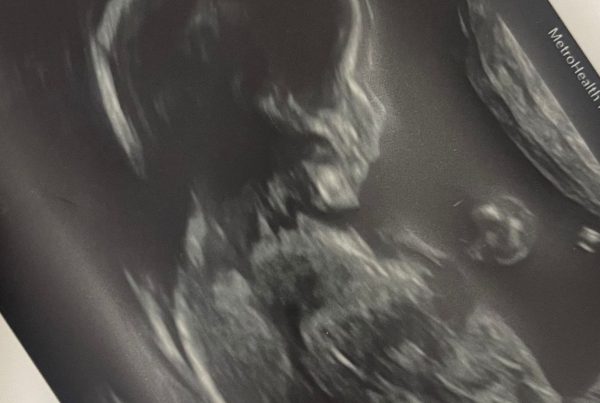Pregnancy can be an exciting time. You will go through several changes as your baby develops, and MetroHealth is here to answer your questions as your pregnancy progresses.
We’ve developed a series of e-mails tailored to your due date that has helpful information about pregnancy and what to expect when you’re delivering at MetroHealth. Click here to sign up.
Your First Trimester
You’ve probably heard of “morning sickness,” but nausea is a common symptom during your first trimester, no matter what time of day.
Tips to deal with nausea during pregnancy:
- When you first wake up, have a small, bland snack like plain crackers.
- Eat smaller meals more frequently throughout the day to avoid feeling full.
- Ginger ale and peppermint tea can help ease nausea.
- Drink plenty of water—aim for 64 ounces per day—to avoid dehydration.
- Avoid greasy and spicy foods, and avoid strong food odors.
Month 4
In month 4, your baby is as big as a pear. If you experienced nausea in the first trimester, it might start going away.
By 16 weeks, your body is starting to experience notable changes. Your baby is developing, too. Most notably, eyes and ears are starting to work. You can start talking to your baby and singing lullabies.
You may start to urinate more frequently than before, thanks to your growing uterus and hormones that are helping your body adjust to pregnancy. Consider cutting out caffeine and not drinking water right before bed to have longer periods of sleep.
Month 5
In month 5, your baby is as big as a grapefruit. Those aren’t butterflies in your stomach—the fifth month is when you may start to feel tiny flutters called “quickening.” Some mothers will not feel quickening as easily as others or as early as others.
You’ll also have an ultrasound soon, if you haven’t already. You should be prepared for an hour-long scan, two hours if you are having twins. So, if you have other children you may need to arrange childcare for them during this time if they have difficulty keeping still.
You’ll be able to watch as the provider takes measurements of the baby to track growth. You’ll get a photo of your baby to take home.
Month 6
In month 6, your baby is as big as a papaya.
As you prepare for delivery, you may start to feel Braxton Hicks contractions. Braxton Hicks contractions are often called “warm up” contractions, because they are preparing your uterus to be strong for birth.
If you feel contractions more than every 15 minutes, sit down, rest, drink water, and try to urinate—especially if you’ve been active or in the heat. If contractions are still occurring more than every 15 minutes, you should go to labor and delivery triage.
Month 7
In month 7, your baby is as big as a pineapple. As your baby grows, you may start to experience some back pain.
As the uterus grows, your abdominal muscles become less effective and you rely on the back and hips to stabilize yourself. Also, the pelvis begins to separate in the middle to create more space for your baby to deliver.
Some back pain isn’t normal, and deserves attention from your provider. Back pain that comes in waves every few minutes, and back pain with fever, chills, vaginal bleeding, or burning during urination can be signs of complications. Visit the OB emergency triage if you have these concerns.
Less frequent back pain is expected, since you’re carrying a baby and your center of gravity is changing. To help ease back pain, consider:
- Checking in on your posture. Keep your shoulders back and remind yourself to sit or stand straight throughout the day.
- Sleep on your side, and use support pillows between your knees or behind your back.
- Keep active, and include stretching or yoga in your daily exercise routine.
- Ditch high heels for comfortable shoes with arch support.
- Consider heat packs, Tylenol, and a maternity belt to ease pain.
Month 8
In month 8, your baby is as big as a cantaloupe. As your baby grows, you may start to notice varicose veins.
Varicose veins are blue or purple veins that usually occur on your legs. They are normal for some—not all!—pregnant people, and can be itchy.
When pregnant, the uterus puts more force on veins, which can cause varicose veins. The body also makes hormones that dilate your veins to help keep enough blood flow to the baby in pregnancy. Sometimes the varicose veins can just be small, more apparent veins around the calves that don’t bother you and will resolve after the pregnancy.
While varicose veins are unavoidable for some people, you can reduce discomfort by:
- Limiting long periods of sitting or standing—move around and take it easy!
- Put your feet up while sitting.
- Sleep on your left side of your body.
- Compression stockings can limit symptoms, but they don’t prevent varicose veins from forming.
For most people, varicose veins improve after delivery. If you have one leg that becomes swollen and painful, you could have a deep vein clot rather than varicose veins, and you need to be evaluated by a doctor.
Month 9
In month 9, your baby is as big as a miniature watermelon.
You will feel the baby drop down in the uterus in preparation for the journey through the birth canal. This means you’re preparing for labor and your baby is moving into position.
It’s time to take a practice run to the hospital so you know where you are going ahead of time and where you will park.
How will you know when it’s time to come to the hospital? Remember 5-1-1. When your contractions are 5 minutes apart, last 1 minute, and you’ve experienced this pattern for 1 hour, you should go to the MetroHealth Birthing Center to be checked by a provider. If you have any bleeding with contractions or you have any fluid coming from your vagina, you should go to the MetroHealth Birthing Center.











